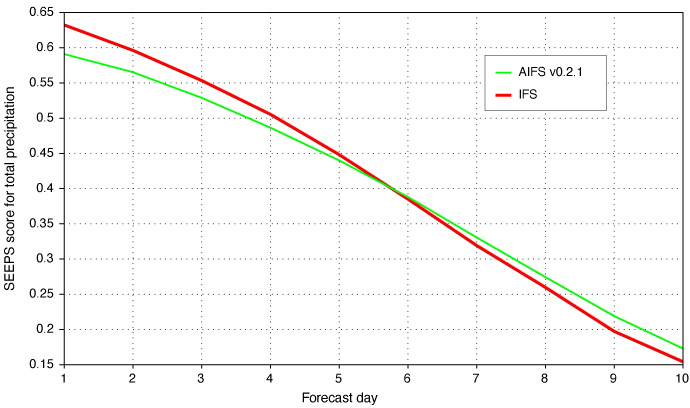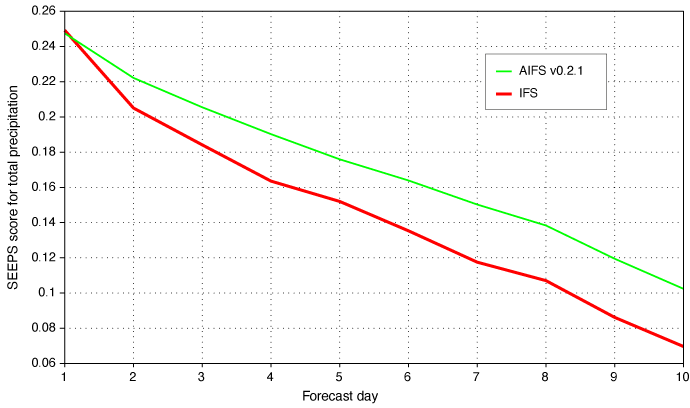We have two exciting updates to bring you from the AIFS team.
Firstly, on 21 February, we updated the AIFS to version 0.2.1. The architecture and training regime stay much the same as the previous version, but the big addition is precipitation, both total and the convective contribution. Charts for total precipitation and total column water can now be found in our web charts.
In the figure, we show some precipitation scores for this new model, assessed against station observations from around the world across the year 2022, measuring 24-hour accumulated precipitation. The score used is Stable Equitable Error in Probability Space (SEEPS), which assesses the performance of a forecast across climatological terciles of dry, light and heavy rain. Larger SEEPS scores (closer to one) indicate higher quality forecasts assessed across all three categories. In the northern hemisphere extratropics, we see that the IFS leads the way for the first 4 days, and the AIFS v0.2.1 leads slightly for day 6 and beyond. In the tropics, scores are lower overall, but the AIFS outperforms the IFS from day 2 onwards.


Comparison between the AIFS v0.2.1 and the IFS for 24-hour accumulated total precipitation assessed against station observations using the SEEPS score (larger numbers indicate a more skilful forecast), aggregated over the year 2022. Scores are plotted for the northern hemisphere extratropics (top) and tropics (bottom).
For the AIFS team, this is a great start, but we think there’s more to come and we’ll be testing some ideas to improve these precipitation forecasts. More detailed evaluation will be needed to understand how the AIFS compares with the IFS across the terciles.
Secondly, on 28 February, ECMWF expanded the open data we provide to the world. This meant an increase in resolution and products for the IFS, but of more interest in the context of AL/ML is the arrival of AIFS data. We now distribute AIFS forecasts 4 times a day, out to 15 days, providing all the output variables of the AIFS on a regular 0.25° latitude–longitude grid. We’re really interested to see what the community makes of our raw forecast data, and it’s been pleasing to see that the eagle-eyed open-data watchers are already using it!
What’s next for the AIFS team? We’re working on a paper documenting the AIFS, on developing our ensemble version of the AIFS, on improving precipitation and a few more surprises. We’ll be back soon for another update. Thanks for reading.
Authors
Matthew Chantry and the rest of the AIFS team (Rilwan Adewoyin, Mihai Alexe, Zied Ben Bouallègue, Mariana Clare, Jesper Dramsch, Simon Lang, Christian Lessig, Linus Magnusson, Michael Maier-Gerber, Gert Mertes, Gabriel Moldovan, Ana Prieto Nemesio, Cathal O’Brien, Florian Pinault, Baudouin Raoult, Mario Santa Cruz, Steffen Tietsche)
